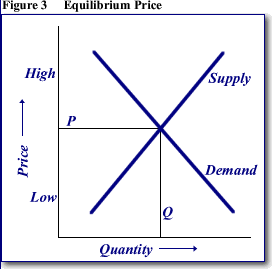The total effect of a price change is actually combined of two different effects:
"… he intends only his own gain, and he is in this, as in many other cases, led by an invisible hand to promote an end which was no part of his intention." Adam Smith, Wealth of Nations.
If the only forces working in the market are demand and supply, buyers and
sellers behave as if their actions are coordinated by an unobservable factor
(even if they are ignorant of the demand and supply rules) and equilibrium
is reached. This unseen coordinating factor is called the "Invisible Hand"
and is actually the "Price Mechanism" which aggregates the information
of all market participants.
Price and quantity demanded move in opposite directions, ceteris paribus (holding everything else constant). A decrease in price leads to an increase in quantity demanded. Likewise, an increase in price causes quantity demanded to fall.
When this relationship between price and quantity demanded is graphed, it is called the demand curve.
|
The total effect of a price change is actually combined of two different effects: |
1) Income effect: As the price of a commodity rises, it may be considered as if the income of the consumer has declined. Therefore, the income effect of a change in price tells us that as price rises quantity demanded would fall.
2) Substitution effect: As the price of a commodity rises, it becomes relatively more expensive than the substitute goods. Hence, consumers substitute in the alternative product in for the good whose price has risen. Therefore, the substitution effect of a change in price also tells us that as price rises the quantity demanded would fall.
|
|
Normal goods: Ceteris paribus, if demand increases as we increase income, then the good is called a "normal good".
Inferior goods: Ceteris paribus, if demand decreases as we increase income, then the good is called an "inferior good".
Note that the income effect and the substitution effects work in the same direction for a normal good. Although they work in opposite directions for an inferior good, as long as the substitution effect dominates the income effect, as price rises the quantity demanded for an inferior good would fall.
Giffen goods: If the income effect dominates the substitution effect and they work in opposite directions, then the good is called a Giffen good. In such a case we would observe a positive relationship between the price of the good and the quantity of the good demanded.
"Legend has it that the English economist Robert Giffen observed this paradox in nineteenth-century Ireland- when the price of potatoes rose, people reportedly consumed more of them. This peculiar result can be explained by looking at the size of the income effect of a change in the price of potatoes. Potatoes were not only inferior goods but also used up a large portion of the Irish people's income. An increase in the price of potatoes therefore reduced real income substantially. The Irish were forced to cut back on other luxury food consumption in order to buy more potatoes. Even though this rendering of events is historically implausible, the possibility of an increase in the price of a good has come to be known as Giffen's paradox." W. Nicholson (1995), Microeconomic Theory: Basic Principles and Extensions, pp. 144-145.
|
What if Prices of other goods change when holding other things constant? |
Substitutes: Ceteris paribus, if the demand for the product declines as the price of another good decreases, then the two goods are said to be "substitutes". Substitutes are goods that can be used in place of each other like hamburgers and hot dogs, vacation in Antalya and vacation in Izmir, dolmus ride and bus ride etc. As the price of the hot dog rises, consumers substitute in more hamburgers for hot dogs, therefore the demand for burgers rise.
Complements: Ceteris paribus, if the demand for the product increases as the price of another good decreases, then the two goods are said to be "complements". Complements are goods that are consumed together like hamburgers and french fries, cars and car insurance, cars and gasoline etc. As the price of automobiles rise, consumers purchase fewer cars and therefore they need less car insurance. As a result the demand for car insurance declines.
Price and quantity supplied move in the same direction. A decrease in price leads to a decline in quantity supplied, Ceteris Paribus. Whereas, an increase in price causes the quantity supplied to rise.
When this relationship between price and quantity supplied is graphed, it is called the supply curve. The supply curve is actually the Marginal Cost curve above the point it intersects with the average variable cost (at the minimum point of the AVC curve called the shutdown point).
Equilibrium occurs at the point where the demand curve intersects the supply curve. At this point the price is such that the quantity supplied is exactly equal to the quantity demanded. In other words, the market clears. Changes in other conditions may cause the market to come to equilibrium at a different point.

Links to information about these topics:
http://ingrimayne.saintjoe.edu/econ/DemandSupply/Demand3.html
http://futures.tradingcharts.com/learning/law_of_demand.html
http://futures.tradingcharts.com/learning/law_of_supply.html